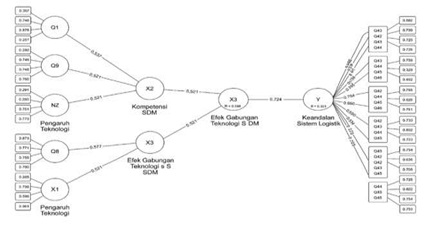The Influence of Technological Developments and Human Resource Competence on the Reliability of the Logistics System of the Indonesian Navy Aviation Center
Abstract
This research investigates the impact of technological development and human resource competence on thereliability of the logistics system within the Indonesian Naval Aviation Center (Puspenerbal). Using aquantitative approach and SmartPLS analysis, the study surveyed 136 personnel directly involved in logisticsmanagement. The variables examined include technological influence (innovation, adaptability, communicationand collaboration), human resource competence (knowledge, skills, experience), combined effects of technologyand HR competence (operational efficiency, risk management, technological usability), and logistics systemreliability (timeliness, stock availability, service quality). Results show that both technological advancement andHR competence significantly influence logistics reliability, with operational efficiency and risk managementacting as key mediating factors. The study highlights the importance of integrating advanced digital logisticssystems with continuous HR development to enhance operational readiness. These findings provide strategicinsights for strengthening defense logistics management, ensuring timely and effective support for navalaviation operations.
References
(Size 8) S. M. Metev and V. P. Veiko, Laser Assisted Microtechnology, 2nd ed., R. M. Osgood, Jr., Ed. Berlin, Germany: Springer-Verlag, 1998.
J. Breckling, Ed., The Analysis of Directional Time Series: Applications to Wind Speed and Direction, ser. Lecture Notes in Statistics. Berlin, Germany: Springer, 1989, vol. 61.
S. Zhang, C. Zhu, J. K. O. Sin, and P. K. T. Mok, “A novel ultrathin elevated channel low-temperature poly-Si TFT,” IEEE Electron Device Lett., vol. 20, pp. 569–571, Nov. 1999.
M. Wegmuller, J. P. von der Weid, P. Oberson, and N. Gisin, “High resolution fiber distributed measurements with coherent OFDR,” in Proc. ECOC’00, 2000, paper 11.3.4, p. 109.
R. E. Sorace, V. S. Reinhardt, and S. A. Vaughn, “High-speed digital-to-RF converter,” U.S. Patent 5 668 842, Sept. 16, 1997.
(2002) The IEEE website. [Online]. Available: http://www.ieee.org/
M. Shell. (2002) IEEEtran homepage on CTAN. [Online]. Available: http://www.ctan.org/tex-archive/macros/latex/contrib/supported/IEEEtran/
FLEXChip Signal Processor (MC68175/D), Motorola, 1996.
“PDCA12-70 data sheet,” Opto Speed SA, Mezzovico, Switzerland.
A. Karnik, “Performance of TCP congestion control with rate feedback: TCP/ABR and rate adaptive TCP/IP,” M. Eng. thesis, Indian Institute of Science, Bangalore, India, Jan. 1999
.[11] J. Padhye, V. Firoiu, and D. Towsley, “A stochastic model of TCP Reno congestion avoidance and control,” Univ. of Massachusetts, Amherst, MA, CMPSCI Tech. Rep. 99-02, 1999.
Wireless LAN Medium Access Control (MAC) and Physical Layer (PHY) Specification, IEEE Std. 802.11, 1997.







